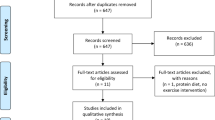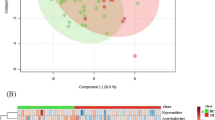Abstract
Objective:
Obstructive sleep apnea (OSA), attention deficit/hyperactivity disorder (ADHD), type 2 diabetes mellitus and psychopathological problems co-occur at increased rates among both obese and enuretic children. We hypothesized that the prevalence of enuresis will be increased in obese children and adolescents.
Design:
A cross-sectional study.
Subjects:
281 children and adolescents aged 7–18 years, who completed a questionnaire regarding enuresis, medical conditions and sociodemographic parameters; 158 were normal weight, 37 overweight (85th⩽BMI (body mass index)<95th percentiles) and 86 obese (BMI⩾95th percentile).
Main outcome measure(s):
Occurrence of enuresis among obese children and adolescents.
Results:
Enuresis was reported in 14 (8.8%) normal weight, 6 (16%) overweight and 26 (30%) obese youth. Odds ratio (OR)=6.5, 95% confidence interval (CI)=2.67–15.78 for enuresis among obese compared with normal weight (P<0.0001). Each increment of one BMI-Z score unit was associated with an increased risk of enuresis, OR of 2.14, 95% CI (1.46–3.12), P=0.00008. Male gender (OR 2.84, 95% CI (1.10–5.58), P=0.028), first-degree relative with current/past enuresis (OR 4.24, 95% CI (1.62–11.08), P=0.003), voiding dysfunction symptoms (OR 3.067, 95% CI (1.05–9.00), P=0.041) and ADHD (OR 2.31, 95% CI (0.99–5.34), P=0.051) increased the risk of enuresis. OSA-related symptoms, academic achievements in school, sharing a bedroom, family size relative to number of rooms in home, parental education, family status and religious observance were not found to increase the risk for enuresis.
Conclusions:
Obese children are at increased risk for enuresis. Enuresis should be clarified during the primary workup of every obese child and adolescent.
This is a preview of subscription content, access via your institution
Access options
Subscribe to this journal
Receive 12 print issues and online access
$259.00 per year
only $21.58 per issue
Buy this article
- Purchase on Springer Link
- Instant access to full article PDF
Prices may be subject to local taxes which are calculated during checkout
Similar content being viewed by others
References
Nevéus T, von Gontard A, Hoebeke P, Hjälmås K, Bauer S, Bower W et al. The standardization of terminology of lower urinary tract function in children and adolescents: report from the Standardization Committee of the International Children's Continence Society. J Urol 2006; 176: 314–324.
Weaver A, Dobson P . Nocturnal Enuresis in Children. J Fam Health Care 2007; 17: 159–161.
American Psychological Association. Diagnostic and Statistical Manual of Mental Disorders Vol. 4. American Psychiatric Association: Washington, DC, 1994.
Ozden C, Ozdal OL, Altinova S, Oguzulgen I, Urgancioglu G, Memis A . Prevalence and associated factors of enuresis in Turkish children. Int Braz J Urol 2007; 33: 216–222.
Shreeram S, He JP, Kalaydjian A, Brothers S, Merikangas KR . Prevalence of enuresis and its association with attention-deficit/hyperactivity disorder among US children: results from a nationally representative study. J Am Acad Child Adolesc Psychiatry 2009; 48: 35–41.
Desta M, Hägglöf B, Kebede D, Alem A . Socio-demographic and psychopathologic correlates of enuresis in urban Ethiopian children. Acta Paediatr 2007; 96: 556–560.
Robson WL . Current management of nocturnal enuresis. Curr Opin Urol 2008; 18: 425–430.
Daniels SR, Arnett DK, Eckel RH, Gidding SS, Hayman LL, Kumanyika S et al. Overweight in children and adolescents: pathophysiology, consequences, prevention, and treatment. Circulation 2005; 111: 1999–2012.
Speiser PW, Rudolf MC, Anhalt H, Camacho-Hubner C, Chiarelli F, Eliakim A et al. Childhood Obesity. J Endocrinol Metab 2005; 90: 1871–1887.
Huerta M, Gdalevich M, Haviv J, Bibi H, Scharf S . Ten-year trends in obesity among Israeli schoolchildren: 1990–2000. Acta Pediatr 2006; 95: 444–449.
Ogden CL, Carroll MD, Curtin LR, Lamb MM, Flegal KM . Prevalence of high body mass index in US children and adolescents, 2007–2008. JAMA 2010; 303: 242–249.
Han JC, Lawlor DA, Kimm SY . Childhood obesity. Lancet 2010; 375: 1737–1748.
Aydil U, Işeri E, Kizil Y, Bodur S, Ceylan A, Uslu S . Obstructive upper airway problems and primary enuresis nocturna relationship in pediatric patients: reciprocal study. J Otolaryngol Head Neck Surg 2008; 37: 235–239.
Barone JG, Hanson C, DaJusta DG, Gioia K, England SJ, Schneider D . Nocturnal enuresis and overweight are associated with obstructive sleep apnea. Pediatrics 2009; 124: e53–e59.
Nield LS, Kamat D . Enuresis: how to evaluate and treat. Clin Pediatr (Phila) 2004; 43: 409–415.
Tauman R, Gozal D . Obesity and obstructive sleep apnea in children. Paediatr Respir Rev 2006; 7: 247–259.
Szabo L, Barkai L, Lombay B . Urinary flow disturbance as an early sign of autonomic neuropathy in diabetic children and adolescents. Neurourol Urodyn 2007; 26: 218–221.
Vinik AI, Maser RE, Mitchell BD, Freeman R . Diabetic autonomic neuropathy. Diabetes Care 2003; 26: 1553–1579.
Erermis S, Cetin N, Tamar M, Bukusoglu N, Akdeniz F, Goksen D . Is obesity a risk factor for psychopathology among adolescents. Pediatr Int 2004; 46: 296–301.
Lam LT, Yang L . Overweight/obesity and attention deficit and hyperactivity disorder tendency among adolescents in China. Int J Obes (Lond) 2007; 31: 584–590.
Waring ME, Lapane KL . Overweight in children and adolescents in relation to attention-deficit/hyperactivity disorder: results from a nation sample. Pediatrics 2008; 122: e1–e6.
Nevéus T . Diagnosis and management of nocturnal enuresis. Curr Opin Pediatr 2009; 21: 199–202.
Elia J, Takeda T, Deberardinis R, Burke J, Accardo J, Ambrosini PJ et al. Nocturnal enuresis: a suggestive endophenotype marker for a subgroup of inattentive attention-deficit/hyperactivity disorder. J Pediatr 2009; 155: 239–244.e5.
Burgu B, Aydogdu O, Gurkan K, Uslu R, Soygur T . Lower urinary tract conditions in children with attention deficit hyperactivity disorder: correlation of symptoms based on validated scoring systems. J Urol 2011; 185: 663–668.
Erdem E, Lin A, Kogan BA, Feustel PJ . Association of elimination dysfunction and body mass index. J Pediatr Urol 2006; 2: 364–367.
Guven A, Giramonti K, Kogan BA . The effect of obesity on treatment efficacy in children with nocturnal enuresis and voiding dysfunction. J Urol 2007; 178 (4 Part 1): 1458–1462.
Pitrou I, Shojaei T, Wazana A, Gilbert F, Kovess-Masféty V . Child overweight, associated psychopathology, and social functioning: a French school-based survey in 6- to 11-year-old children. Obesity (Silver Spring) 2010; 18: 809–817.
Vila G, Zipper E, Dabbas M, Bertrand C, Robert JJ, Ricour C et al. Mental disorders in obese children and adolescents. Psychosom Med 2004; 66: 387–394.
Boutelle KN, Hannan P, Fulkerson JA, Crow SJ, Stice E . Obesity as a prospective predictor of depression in adolescent females. Health Psychol 2010; 29: 293–298.
Rojas A, Storch EA . Psychological complications of obesity. Pediatr Ann 2010; 39: 174–180.
Baeyens D, Roeyers H, Vande Walle J, Hoebeke P . Behavioural problems and attention-deficit hyperactivity disorder in children with enuresis: a literature review. Eur J Pediatr 2005; 164: 665–672.
U.S. National Center for Health Statistics. Centers for Disease Control and Prevention Growth Charts. http://www.cdc.gov/nchs/about/major/nhanes/growthcharts/charts.htm (accessed 11 September 2010).
About BMI for Children and Teens | DNPAO | CDC. http://www.cdc.gov/healthyweight/assessing/bmi/childrens_bmi/about_childrens_bmi.html (accessed 13 September 2010).
Goldstein A, Haelyon U, Krolik E, Sack J . Comparison of body weight and height of Israeli schoolchildren with the Tanner and Centers for Disease Control and Prevention growth charts. Pediatrics 2001; 108: E108.
R-Development-Core-Team. R: A Language and Environment for Statistical Computing. R Foundation for Statistical Computing: Vienna, Austria, 2010.
Stein RI, Epstein LH, Raynor HA, Kilanowski CK, Paluch RA . The influence of parenting change on pediatric weight control. Obes Res 2005; 13: 1749–1755.
Fishman L, Lenders C, Fortunato C, Loonan C, Nurko S . Increased prevalence of constipation and fecal soiling in a population of obese children. J Pediatr 2004; 145: 253.
Schwartz AR, Patil SP, Squier S, Schneider H, Kirkness JP, Smith PL . Obesity and upper airway control during sleep. J Appl Physiol 2010; 108: 430–435.
Author information
Authors and Affiliations
Corresponding author
Ethics declarations
Competing interests
The authors declare no conflict of interest.
Rights and permissions
About this article
Cite this article
Weintraub, Y., Singer, S., Alexander, D. et al. Enuresis—an unattended comorbidity of childhood obesity. Int J Obes 37, 75–78 (2013). https://doi.org/10.1038/ijo.2012.108
Received:
Revised:
Accepted:
Published:
Issue Date:
DOI: https://doi.org/10.1038/ijo.2012.108
Keywords
This article is cited by
-
Obesity contributes to lower urinary system voiding dysfunction in childhood
Irish Journal of Medical Science (1971 -) (2021)
-
Obstructive Sleep Apnea in School-Aged Children Presented with Nocturnal Enuresis
Lung (2020)
-
Nocturnal enuresis in obese children: a nation-wide epidemiological study from China
Scientific Reports (2019)
-
Current perspectives on the correlation of nocturnal enuresis with obstructive sleep apnea in children
World Journal of Pediatrics (2019)



